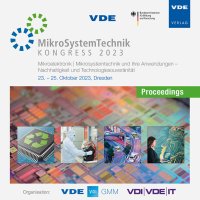Highly Conductive Thermally Reduced Graphene Oxide Films via Transition Metal Catalyzed Graphitization
Konferenz: MikroSystemTechnik Kongress 2023 - Kongress
23.10.2023-25.10.2023 in Dresden, Deutschland
Tagungsband: MikroSystemTechnik Kongress 2023
Seiten: 4Sprache: EnglischTyp: PDF
Autoren:
Niemann, Leonhard (Robert Bosch GmbH – Department of Advanced Technologies and Micro Systems, Renningen, Germany & Chemnitz University of Technology – Institute of Physics, Chemnitz, Germany)
Gruschwitz, Markus; Sellge, Gabriel; Tegenkamp, Christoph (Chemnitz University of Technology – Institute of Physics, Chemnitz, Germany)
Koehne, Martin (Robert Bosch GmbH – Department of Advanced Technologies and Micro Systems, Renningen, Germany)
Hellwig, Olav (Chemnitz University of Technology – Institute of Physics, Chemnitz, Germany & Helmholtz Zentrum Dresden Rossendorf (HZDR) – Institute of Ion Beam Physics and Materials Research, Dresden, Germany & Chemnitz University of Technology – Center for Materials, Architecture and Integration of Nanomembranes (MAIN), Chemnitz, Germany)
Inhalt:
The growing demand for flexible electronics and efficient heat dissipation increases the interest in carbon-based materials. Flexible graphene films are commonly used as heat spreaders in devices with limited space, e.g., smartphones. A potential future application for graphene or graphite films is their use as electrical conductors in mobile applications like electric motors for electrical vehicles. However, the current electrical conductivity is not sufficient to compete with copper-based conductors. Commercially available graphite films are based on polymers that are graphitized at certain stress and temperature conditions. Alternatively, graphene oxide flakes are utilized as the starting material. However, the final graphene film properties depend strongly on the properties of the used graphene oxide flakes. High thermal annealing temperatures, high graphene film density and large single graphene oxide flakes are three important parameters. Different additives are evaluated to boost the electrical conductivity. Here, the influence of copper and nickel as catalysts for the graphitization of graphene oxide was studied. The electrical conductivity was measured on various length scales by a contactless eddy current method and a four-point probe scanning tunneling microscope (4pp-STM). The maximum annealing temperatures and used metal concentrations were varied and revealed an optimum annealing temperature of 2850 °C and a concentration of 8.8 mmol/L NiCl2 resulting in an electrical conductivity of 609.95 kS/m. The electrical conductivity is 31 % higher than the reference graphite film synthesized without additives measured in 4pp-STM. Our transport findings correlate well with the structural analyses of our films done by X-ray diffraction and scanning electron microscopy.


